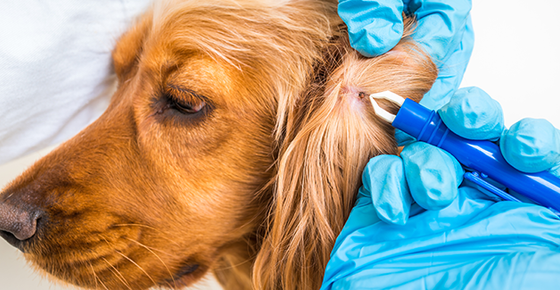
How to Prevent and Remove Ticks
Lyme disease is a top concern for dog owners who enjoy walking with their dog in grassy and wooded areas. Transmitted by deer ticks, Lyme disease can result in fever, joint lameness, fatigue, and general discomfort for your pet. While treatment is available, Lyme disease is best prevented. Here is how to prevent Lyme disease and remove troublesome ticks.
Prevention Tips:
Try to avoid heavily wooded areas or tall grass when walking your pet.
Always be sure you check for ticks as soon as you are done with your walk. Make a point to investigate everyone in the family before returning to the car after a hike.
Be thorough when looking for ticks. Check in places your pet cannot get at such as the back of the head and neck. Ticks will tend to bury themselves in areas pets cannot reach.
Remove any tick(s) you find promptly and dispose of them properly. Proper disposal means killing the tick before disposing of it in a secured trash can.
Use a topical formula such as Frontline to help keep ticks from "digging in" to your pet. Frontline is a topical formula developed in France for children with head lice. Knowing it was developed for humans should make you feel comfortable about putting it on your pet. Apply the product to the back of the neck where the pet can not lick it off or get its paw up to scratch and then lick and ingest.
We can help you put this on or show you the first time. There are also instructions in the package. It is easy to apply and should be applied monthly. Frontline does not allow the tick to penetrate the skin. Instead it kills the tick and the tick falls off.
Instructions for Removing a Tick:
If you find a tick on your pet, get a pair of fine-nosed tweezers to remove it. Wash the tweezers with warm, soapy water before and after use. Wash your hands as well.
Have someone hold your pet so they do not get distracted and move on you.
Grasp the head of the tick as close to the skin as possible. Do not squeeze the body of the tick! You want the nose, not the body.
Pull the tick straight out. You may have to be firm when you pull. This is okay and should not hurt your pet.
Put the tick into a small jar of rubbing alcohol (to kill it). You can also flush the tick, or run it through the garbage disposal with hot water.
Rub the area with rubbing alcohol to kill germs, and petroleum jelly (if it is not in an area where your pet will lick it off) to sooth the area.
If you notice a rash or anything red, blotchy, itchy, etc., make an appointment to have your pet checked. A fever, sudden joint lameness, fatigue, and not eating are other signs it is time to give us a call!
